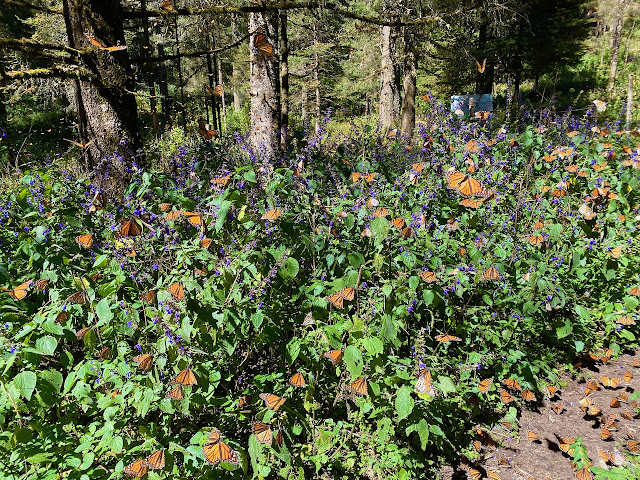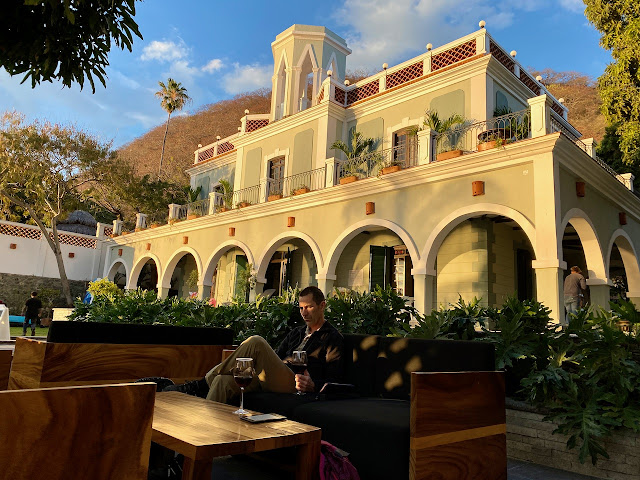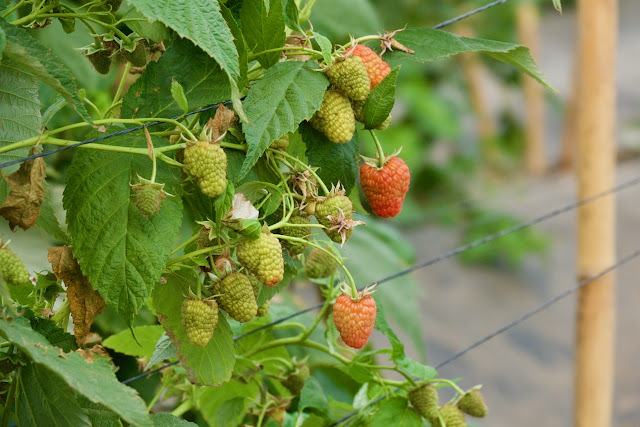 |
| Me launching |
It was relatively easy to get the flying in Tapalpa figured out. We initially headed to the launch area, only to miss the turnoff, so decided to head down the hillside to see if we could find the landing zone. Unfortunately the LZ wasn't marked on the paradgliding earth site and although there are lots of landable looking areas, nothing was obvious. We discovered it's probably not marked because the LZ can change depending on what crops are planted where.
We emailed one of the local pilots (whose advertisement we'd seen in the hotel) and headed back up to launch. Miguel answered right away and happened to be on launch managing some tandem flights as we were conversing with him. He was extremely helpful and gave us lots of good local information on where to find the thermals, pointed out the LZ, and hooked us up with Pedro who looks after the site and, for a small price, will drive retrieve.
Since I hadn't flown since summer, I wanted to do some kiting before getting in the air and there is a large top landing area which was the perfect spot.
By this time it was later in the day. I encouraged Andrew to take a flight and I would pick him up. I wanted to check out the LZ up close and personal before landing there.
 |
| Andrew in the air |
The next day we both did short flights in the morning and Pedro picked us up. It felt great to get that first flight done!
 |
| Me in the air |
 |
| View from the front row |
We got back up to launch, left our wings in the vehicle and grabbed our lunch to have a bit to eat before another flight. We observed a pilot just launching as we walked to where we were going to sit. He got a bit of lift right away and turned . . . a wing tip collapsed, then the front, and spun down and crashed into the hillside. I dropped our lunch and a water bottle where I was and Andrew and I both ran down the hill. We were both wondering what we were going to find when we got there and were imagining worst case scenarios.
 |
| Wing in the trees. Further away than it looks in this photo. |
I called out to the person several times along the way, both to make sure Andrew and I were headed in the right direction and to see if he was at least well enough to answer. Thankfully, he was! And luckily there were a few slightly overgrown trails to follow which made getting to him much easier than bushwhacking through very thick jungle type trees and vines.
I was appreciative of search and rescue training and a recent advanced wilderness first aid course (thank you Back40!) as I thought about scenarios of what we might find when we got to the pilot. Although I also thought about my first aid kit which was back in the vehicle! (On debriefing after the incident, we agreed that one of us should have gone to get the first aid kit while the other went to the pilot.)
It look less than five minutes to find him. He was standing up and had his harness part way off. Andrew immediately told him I was with search and rescue which put the pressure on! He complained of a sore shoulder; maybe ribs, maybe wrist. He didn't seem too sure. After asking a few questions, getting his jacket off and observing (looking for blood), I did a head-to-toe secondary assessment. All else seemed good. I took a closer look at his shoulder and didn't see any deformities but by now he was more definite about that being where it hurt the most. We offered to make an improvised sling for him with Andrew's long sleeve shirt but he said it felt better hanging down by his side.
By this time, the pilot's wife (who had been watching on launch) and Pedro (who grabbed a machete before heading down) were there with us. Thankfully the pilot felt well enough to walk out so, with Pedro making a clearer path with his machete, it didn't take us long to get back up to launch. We would have had a heck of a time, and needed a lot more people, to get him out of there if he hadn't been able to walk. He was a big guy!!
As more information came out, we learned that the pilot was using an old, high-end wing that he left in Mexico for times that he came here. His wing back at home in Germany was a more conservative one and it had been a while since he'd flown. It's likely that all of these things factored into his first accident in almost 30 years of flying.
As he went off to hospital to get x-rays, a large group of US and Canada pilots arrived. Paragliding is a small community so we'd met several of them before. We spent the rest of the afternoon "parawaiting" for the wind direction to cooperate so that we could fly again. I was losing motivation (plus thinking about the accident) so once conditions finally changed in the very late afternoon I decided to just drive retrieve. What a gong show trying to get rides figured out for everyone!
 |
| Ready to go but waiting for wind conditions to cooperate |
 |
| Andrew coming in to land |
The next day I skipped the first flight due to a very upset stomach but had a great second flight, lots of lift and thermals in the air. I forgot to mention that Pedro doesn't speak much English and we don't speak much Spanish so our pick up phone conversations are "Hola Pedro. Shelley and Andrew at Piano." "Ok." "Gracias." (Piano is the name of the regular LZ.)
 |
| Looking back towards launch |
 |
| The LZ is one of the large bright green fields to the right of the green houses |
The injured pilot showed up at launch again with a sling/brace around his shoulder and confirmed his shoulder blade was broken. He will have to have the brace on for about 6 weeks. It could have been so much worse! As noted in a podcast we listened to recently, "the ground is hard and unforgiving." In the same podcast, "the ground is fucking hard!"
Anyway, it's been a fun first few days of flying, albeit with a bit more "excitement" than we ever hope for.
 |
| View from launch |
 |
| The paragliding world cup was held here a few years ago and this beautiful shelter was built for it. |
 |
| Mexican flag used as a wind sock to determine wind direction. |
Andrew's blog post about the accident and first few days of flying can be seen
here.


















































